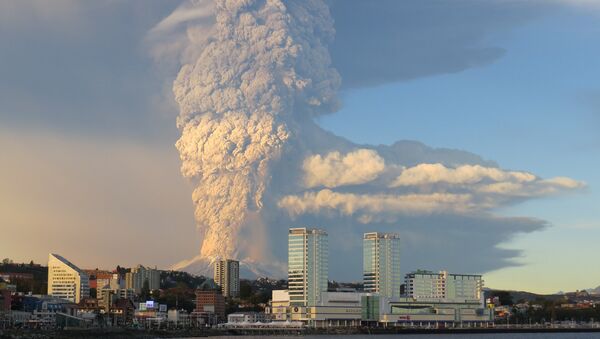— World Facts (@World) April 30, 2015
As vertical clouds of hot ash and volcanic rock were blasted 2.5 miles (4km) into the sky, authorities reiterated that there would be a protection zone in a 20 kilometer "exclusion zone" around the erupting volcano, and that evacuations would intensify.
The eruption that began on April 22 was the first time the volcano had become active in more than 40 years, and it gave residents no warning.
— Eric Holthaus (@EricHolthaus) April 25, 2015
"This latest eruption is much smaller than the other two," Deputy Interior Minister Mahmud Aleuy told reporters at a press conference, adding that some 2,500 people will be evacuated.
Some of the initial evacuations ordered last Wednesday — affecting about 4,500 resident — may have to be repeated as some residents had returned to evaluate the condition of their houses, covered in ash.
— Janine Krippner (@janinekrippner) April 26, 2015
"We were working, cleaning the ash and sand from our homes when this third eruption took place. I feel so much anger and impotence it just breaks me apart," Horacio Camano of Ensenada, 43, told the Associated Press, crying about the evacuation of his family.
"There are no words for having to live this over again — having our families worried about us, all phones collapsed. I just want this to calm down so we can return home."
— Capital Weather Gang (@capitalweather) April 29, 2015
The first two eruptions on that first day of activity spewed ash and fire as far as 11 miles into the air. The clouds created impressive volcanic lightning storms. The World Wide Lightning Location Network recorded over 1,000 strikes around the volcano on April 23 alone.
And the quantity of ash strewn from the 6,500 foot (2000 meter) cone into the atmosphere could even be seen from space.
— Terry W. Virts (@AstroTerry) April 26, 2015
— NASA Earth (@NASA_EO) April 24, 2015
The entire town of Ensenada, near Calbuco, is covered in ash, as are many farms. Rivers flowing with ash have seen huge fish die-offs. Eduardo Aguilera of the National Fishing Service told the AP that about 20 million fish have died, while thousands of cattle and sheep have been evacuated from the region.
— China Xinhua News (@XHNews) April 25, 2015
Local authorities are concerned that rains could cause destructive floods of ashen mud, known as lahars.
"Lahars are possible if we get heavy rains, so it's still a concern," said Rodrigo Alvarez, the head of the National Mining and Geology service. "This emission should begin to weaken in the coming hours and we'll have new forecasts. For now we remain on high alert."
President Michelle Bachelet has declared a state of emergency.
— Woow pics (@photo98765) April 30, 2015


